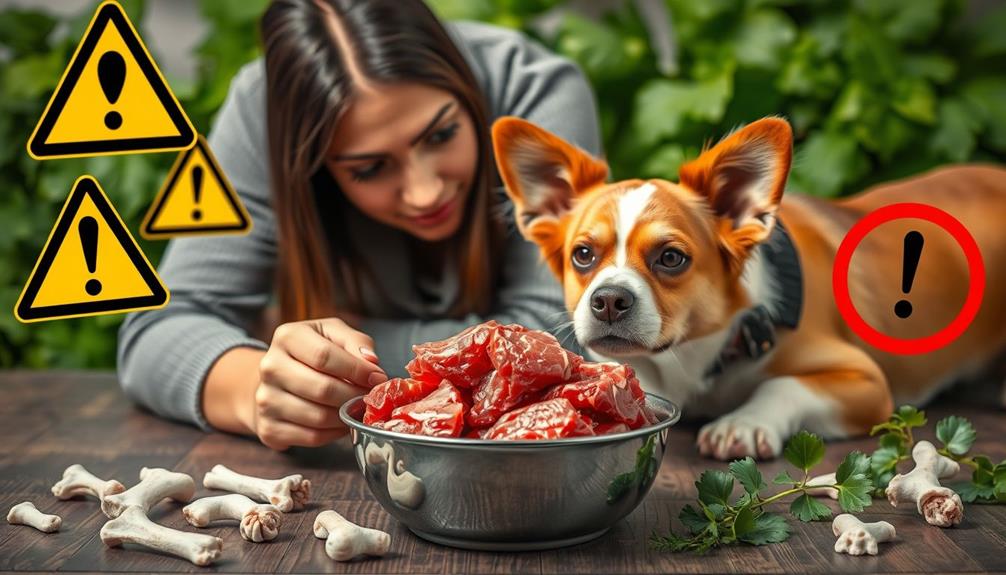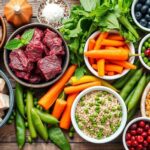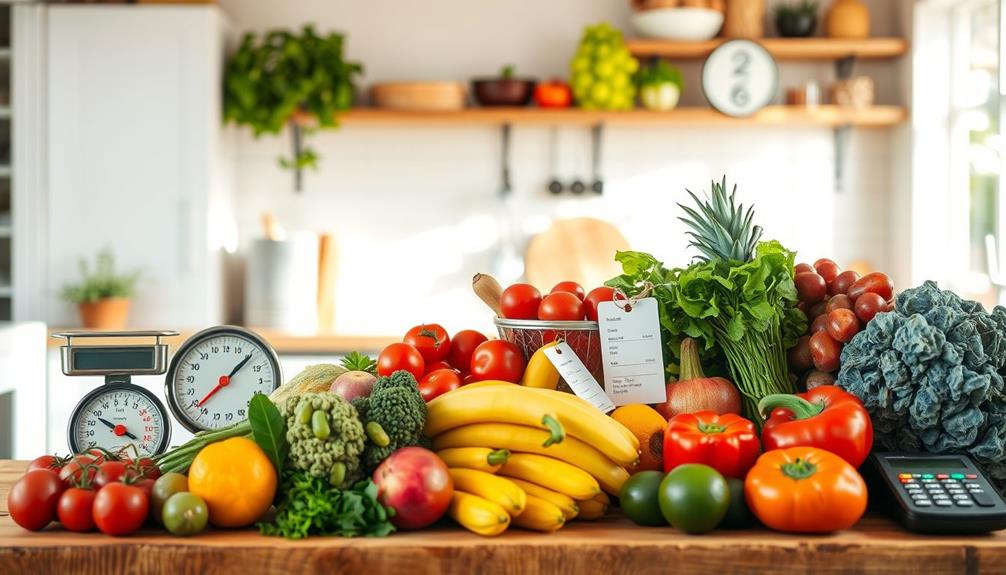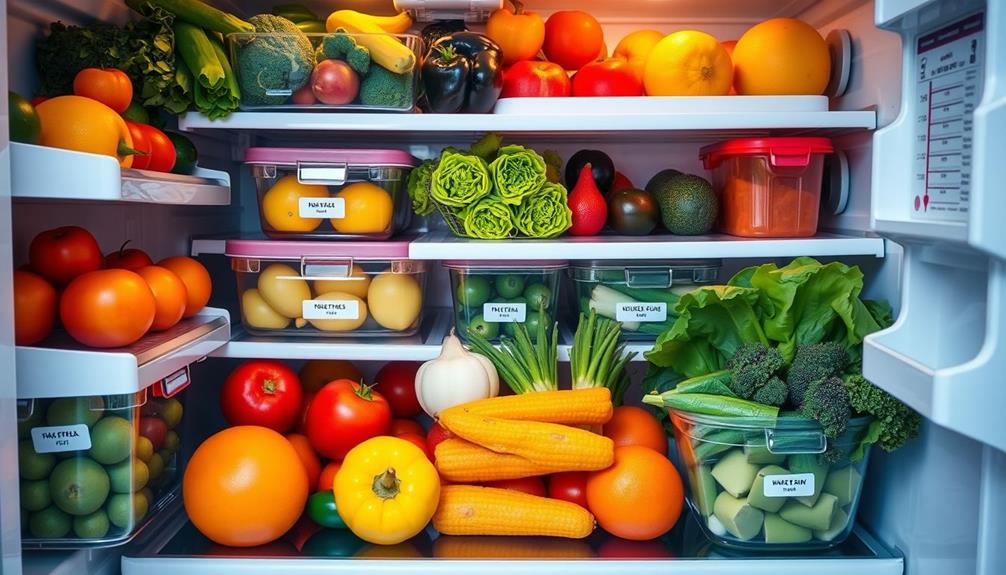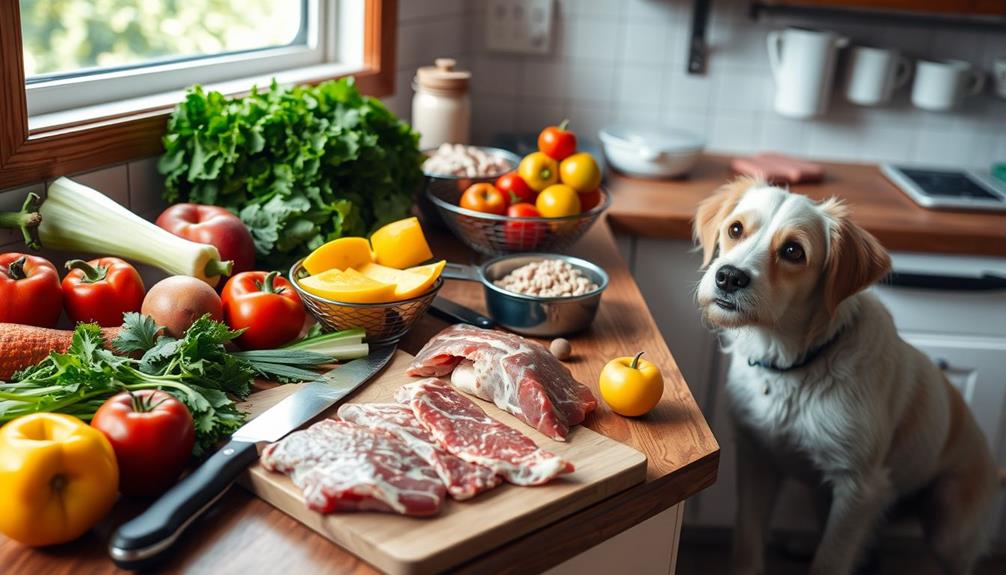You can feed your dog a variety of raw foods to support their health. Start with fresh muscle meats like chicken, beef, and turkey. Include organ meats such as liver and heart for essential nutrients. Raw meaty bones promote dental health, while fish like salmon provides omega-3s. Don't forget fruits and vegetables for extra vitamins and fiber. Eggs are a great protein supplement, too. Make sure to introduce these foods gradually to avoid stomach upset. By exploring the right ingredients and safety tips, you'll find the perfect raw diet for your furry friend. There's plenty more to discover about raw feeding!
Key Takeaways
- Fresh muscle meats like beef, chicken, turkey, and pork are essential protein sources for raw feeding.
- Organ meats, such as liver and kidney, provide vital vitamins and minerals for your dog's health.
- Raw meaty bones promote dental health and supply necessary calcium and phosphorus.
- Include fruits and vegetables to offer fiber, antioxidants, and additional vitamins for overall well-being.
- Eggs can be a protein-rich supplement that can be offered raw or cooked for added nutrition.
Understanding Raw Dog Food
When it comes to feeding your dog, understanding raw dog food is essential. This type of diet typically includes uncooked meats, bones, fruits, and vegetables, aligning with your dog's natural dietary needs.
The BARF diet, which stands for Biologically Appropriate Raw Food, emphasizes balanced nutrition by incorporating raw meats, bones, and plant-based foods. This approach promotes your dog's health and well-being, similar to how juice diets can provide nutritional benefits for humans when done correctly.
Dogs' digestive systems are uniquely adapted to process raw food, allowing them to efficiently digest raw meats while benefiting from the nutrients in fruits and vegetables. Advocates of raw feeding often report health benefits such as improved coat condition, enhanced energy levels, and a reduced risk of obesity-related diseases.
If you're considering this shift to a raw diet, it's vital to do so gradually. A proper feeding guide will help you monitor your dog's health and weight, ensuring dietary adequacy and preventing gastrointestinal upset.
Pay close attention to your dog's reaction to the new diet, making adjustments as necessary. With careful planning and a commitment to balanced nutrition, you can set your dog up for a healthier, happier life.
Essential Ingredients for Raw Feeding

When you're preparing a raw diet for your dog, it's essential to focus on the right meat options and nutrient-rich additions.
Proper diet includes fresh fruits and vegetables that can boost your dog's health and well-being.
You'll want to guarantee safe preparation practices to keep your pup healthy and happy.
Let's explore how to create a balanced raw feeding plan that meets all your dog's nutritional needs.
Meat Options Overview
The foundation of a balanced raw diet for dogs lies in the variety of meat options you choose to include. Start with fresh muscle meats like beef, chicken, turkey, and pork. These raw meat options provide essential proteins and nutrients that support your dog's overall health.
Additionally, considering the potential for allergies or sensitivities, it's recommended to monitor your dog's reaction to new meats and consult with a veterinarian if needed. Don't forget to incorporate organ meats such as liver, kidney, and heart, which are nutrient-dense and supply crucial vitamins and minerals.
Adding raw meaty bones, like chicken necks and wings, is essential too. They not only serve as a source of calcium but also promote dental health through natural chewing.
Fish, including salmon and sardines, can bring in those important omega-3 fatty acids, which are known for promoting healthy skin and a shiny coat.
To guarantee a balanced intake of nutrients, it's important to vary the types of meat and organs you feed your dog. This variety of meat helps prevent potential deficiencies and keeps your furry friend thriving.
Nutrient-Rich Additions
Incorporating nutrient-rich additions into your dog's raw diet can greatly enhance their health and well-being. Start with muscle meat as a primary source of high-quality protein. Adding organ meats like liver and kidneys is essential, as they're packed with vitamins and minerals vital for canine health.
It's also important to take into account the potential benefits of certain natural remedies that can complement your dog's diet.
Raw meaty bones offer a great source of calcium and phosphorus, promoting strong bones and supporting dental health. Just be careful in selecting them to prevent any choking hazards.
Don't forget about fruits and vegetables; options like carrots and blueberries provide fiber, antioxidants, and additional vitamins, contributing to a balanced diet.
Eggs are another fantastic supplement. They're rich in protein, fatty acids, and essential vitamins, and you can offer them raw or cooked based on your dog's dietary needs.
Including fish such as salmon or sardines is beneficial too, as they deliver omega-3 fatty acids that support skin health, coat condition, and immune function.
Safe Preparation Practices
Guaranteeing safe preparation practices for raw feeding is essential for your dog's health and safety. Start by thoroughly washing your hands and surfaces to minimize the risk of bacterial contamination from raw meat. Additionally, understanding your dog's nutritional needs can help you make informed decisions about their diet, as proper budgeting for pet food can lead to healthier choices. Always source high-quality ingredients to avoid harmful additives that could jeopardize your dog's health.
When handling raw food, use separate cutting boards and utensils dedicated solely to raw meat to prevent cross-contamination with other food items. This simple step can considerably reduce the risk of illness for both you and your dog.
For proper defrosting methods, always thaw raw meat in the refrigerator rather than at room temperature. This helps maintain the integrity of the meat and decreases bacterial growth, keeping your dog's meal safe and nutritious.
Lastly, when portioning raw food, be accurate according to your dog's weight and dietary needs. A general guideline is to serve 2-5% of your dog's body weight in raw food daily.
Nutritional Benefits of Raw Diets
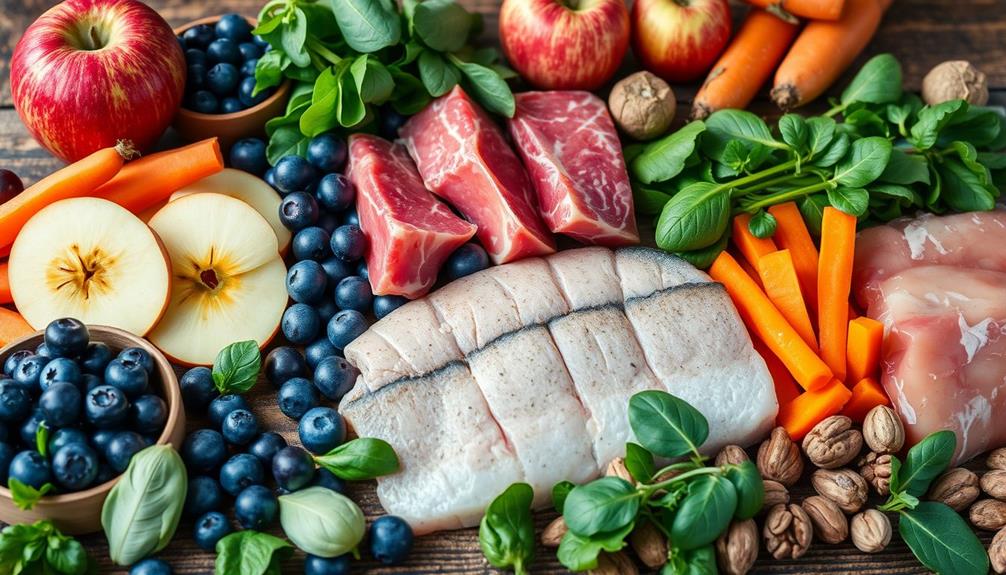
Raw diets offer a wealth of nutritional benefits that closely align with your dog's natural dietary needs. These diets are rich in protein and essential nutrients, promoting overall health and liveliness.
By including raw fruits and vegetables, you provide antioxidants, vitamins, and minerals that support immune function and contribute to healthy skin and coat. Additionally, incorporating a balanced diet with fresh, whole foods can greatly enhance your dog's overall well-being, similar to the importance of a balanced diet for humans.
One major advantage of raw diets is their positive impact on digestion. The unprocessed nature of these foods enhances nutrient absorption, leading to smaller, less odorous stools. This means your dog can enjoy better digestive health and comfort.
A well-balanced raw diet can also help eliminate common health issues like allergies and obesity by incorporating fresh, whole foods without artificial additives.
Moreover, you may notice increased energy levels in your dog, as raw diets often fuel them with the right nutrients. Advocates of raw feeding frequently report improved dental health, attributed to the natural chewing of raw meaty bones.
Risks and Safety Precautions

What should you consider when converting your dog to a raw diet? First, be aware of the risks of feeding raw diets, including potential bacterial contamination like Salmonella and E. coli. These can affect both your dog's and your health, so practicing proper hygiene is essential after handling raw food.
Additionally, understanding the financial implications of dietary changes, such as sourcing high-quality raw ingredients, can be beneficial for planning purposes. It's important to explore financial considerations for elderly care that may parallel the commitment needed for maintaining a raw diet.
Next, be cautious with whole bones, as they can pose choking hazards, break teeth, or cause internal injuries. It's imperative to monitor bone consumption and choose safe cuts to minimize these risks.
Additionally, raw diets often contain higher fat levels, which can benefit your dog's coat health but might lead to pancreatitis if not managed carefully. Striking a balance is key.
If you have a puppy, pay close attention to calcium and phosphorus levels in their diet to avoid growth issues. Following specific formulation guidelines is necessary.
Lastly, regular veterinary check-ups are essential when adapting to a raw diet. They help monitor your dog's health and address any potential issues that may arise from these dietary changes.
Transitioning to Raw Food
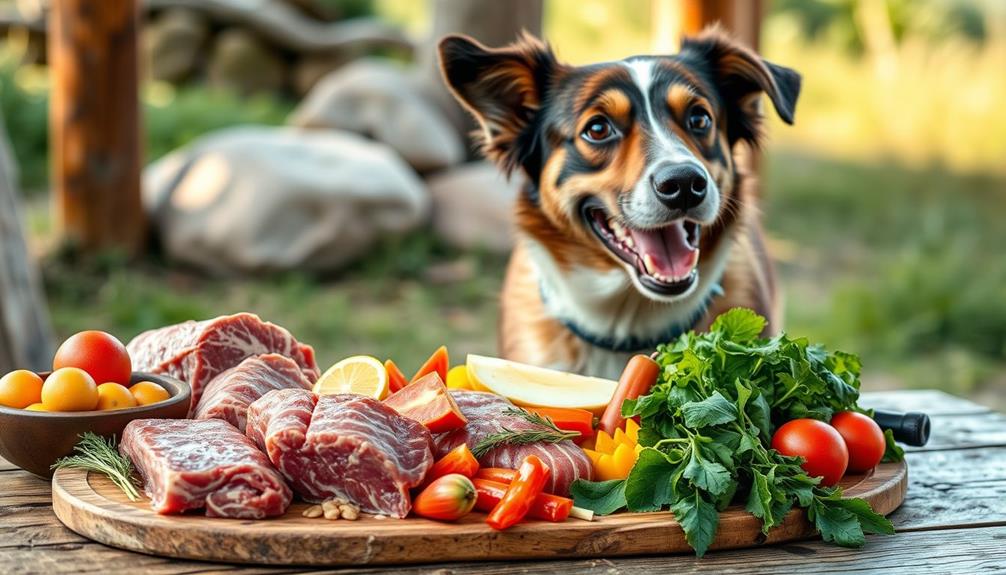
After understanding the risks and safety precautions involved in feeding a raw diet, you might be keen to start implementing this new food regimen for your dog. Shifting to raw can be smooth if you follow some essential steps. For instance, incorporating healthy dog snacks alongside the raw food can enhance their experience and overall satisfaction.
- Start with 20% raw food and 80% of your dog's current food for the first three days.
- Gradually increase the raw food by 20% every few days until reaching 100% raw.
- Monitor your dog for any signs of stomach upset or health issues during the shift.
Typically, moving to raw food diets can take about 7 to 14 days, but for senior dogs or those with health issues, you should proceed more slowly, possibly extending the shift period.
It's vital to monitor the dog's weight and overall health closely. Adjustments based on response are key; if you notice any gastrointestinal distress, slow down the increase in raw food portions.
Remember that daily feeding amounts should generally be 2-5% of your dog's body weight. By following these guidelines, you'll set your dog up for a successful shift to a raw food diet.
Daily Feeding Guidelines
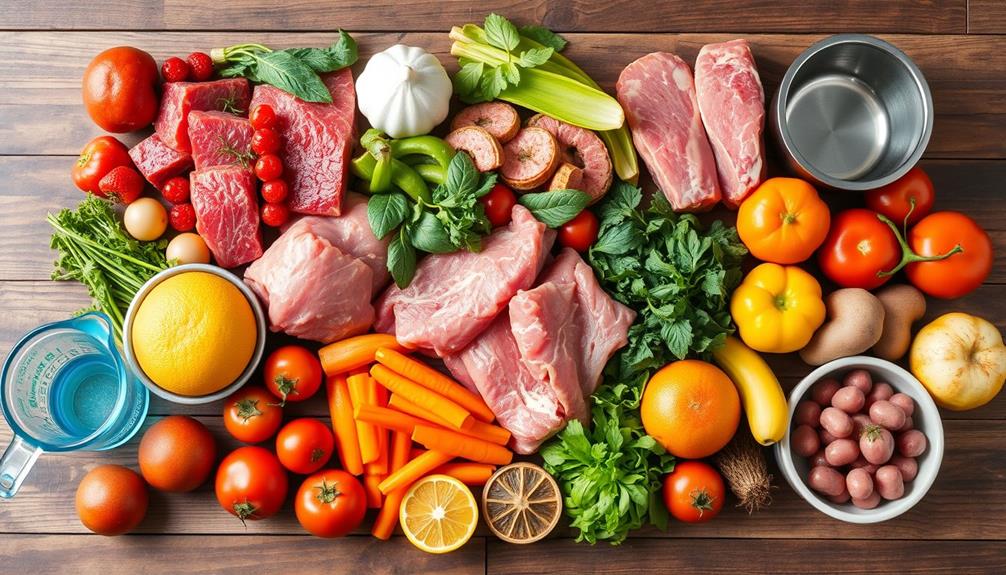
Feeding your dog the right amount of raw food each day is vital for their health and well-being. Daily feeding should generally consist of 2-5% of your dog's body weight in raw food. The exact amount varies based on your dog's weight, health, and activity levels.
During the adjustment period, which typically lasts around 7 days, you'll gradually increase the raw food amount from 20% to 100%. Puppies and healthy adult dogs can often adapt overnight, while senior dogs or those with health issues should make the switch more gradually to avoid stomach upset.
It's important to monitor your dog's weight and health regularly throughout this process. Consider using online raw food calculators for personalized daily feeding amounts tailored to your dog's age, weight, and activity level. This guarantees proper nutritional intake.
Here's a simple guideline to help you get started:
| Dog Type | Feeding Percent | Adjustment Period |
|---|---|---|
| Puppies | 5-10% | Overnight |
| Adult Dogs | 2-5% | 7 Days |
| Senior Dogs | 2-3% | Gradual |
| Dogs with Health Issues | 2-3% | Gradual |
Cost-Saving Strategies
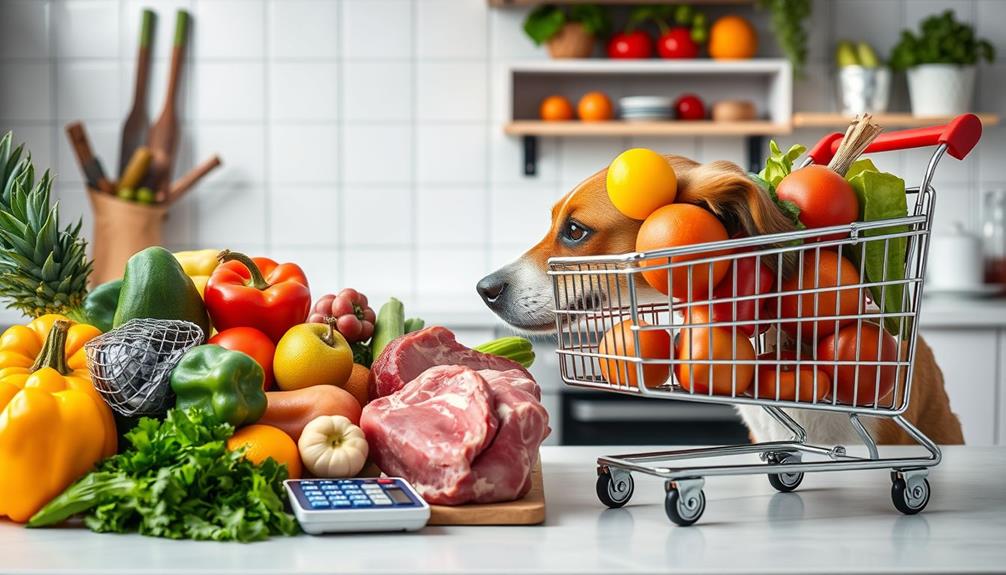
Many dog owners often seek ways to save money while providing a nutritious raw diet for their pets. Here are some cost-saving strategies to take into account: Understanding the nutritional needs of your dog can help you make informed choices about which raw foods to include in their diet, guaranteeing they receive ideal nutrition without overspending.
Additionally, experimenting with various protein sources can lead to discovering innovative coffee gear that can benefit your cooking process.
- Bulk Buying: Purchase raw ingredients like meats and vegetables in bulk from local butchers or farmer's markets to greatly reduce costs.
- Cheaper Cuts: Request cheaper cuts of meat, offal, and raw bones, which offer nutritious options at a fraction of the price of premium cuts.
- Freezing Portions: Prepare homemade raw meals and freeze portions in advance. This saves time during meal prep and guarantees you have ready-to-serve meals without daily preparation.
Additionally, using online raw food calculators can help you determine the ideal portion sizes for your dog, preventing overfeeding and unnecessary expenses.
By taking these steps, you can create a balanced raw diet while keeping your budget intact. Remember, with thoughtful planning and resourcefulness, you can provide your furry friend with the best nutrition without breaking the bank.
Happy feeding!
Community Resources and Support

You're not alone in your raw feeding journey; many local raw food groups and online support communities are enthusiastic to help.
These resources connect you with fellow dog owners who share tips, experiences, and encouragement. Engaging with these communities can provide insights into your dog's dietary needs and the benefits of a raw diet, such as improved health and vigor the importance of community support.
Tapping into these networks can make shifting to a raw diet smoother and more enjoyable for both you and your dog.
Local Raw Food Groups
Joining local raw food groups can be a game-changer for dog owners looking to shift to or maintain a raw diet. These communities offer invaluable resources and support, helping you navigate the world of raw feeding practices.
For example, many groups share tips for managing your dog's health and can help you understand the nutritional needs specific to raw diets. Here are three benefits of joining such a group:
- Knowledge Sharing: Connect with experienced pet owners who can provide tips and insights on balanced raw diets.
- Workshops and Events: Participate in potlucks and seminars where you can learn about raw feeding and exchange experiences.
- Bulk Purchasing Opportunities: Access group buys for high-quality raw ingredients directly from local suppliers or farms, saving you money.
Local raw food groups often leverage social media to create forums for real-time discussions, allowing you to ask questions and share advice.
Many groups also connect you with veterinary professionals or nutritionists, ensuring your dog's diet is nutritious and balanced.
With community support at your fingertips, adapting to or maintaining a raw diet becomes less intimidating. Embrace the camaraderie and expertise within these groups to help your furry friend thrive!
Online Support Communities
Online support communities serve as a valuable resource for dog owners guiding through the raw feeding journey. These platforms allow you to share experiences, tips, and recipes with fellow raw feeders, creating a sense of camaraderie and support.
You'll find expert advice from veterinarians and pet nutritionists, helping you navigate the complexities of raw diets safely.
Many online communities provide essential resources like meal planning guides and health monitoring checklists designed specifically for adapting dogs to a raw diet. These tools take the guesswork out of feeding, ensuring your furry friend receives balanced nutrition.
Active forums and discussion boards enable real-time Q&A, allowing you to seek advice on specific health concerns or feeding practices related to raw diets.
Additionally, membership in these online support communities often grants access to exclusive discounts on raw feeding products and services. This can help you save money while ensuring your dog gets the best nutrition possible.
Engaging with these communities not only enhances your knowledge but also connects you with other passionate dog owners who are on the same journey, making raw feeding a rewarding experience for both you and your pup.
Frequently Asked Questions
What Is a Complete Raw Diet for Dogs?
A complete raw diet for your dog includes 70% muscle meat, 10% edible bone, 5% liver, 5% other organs, and 10% vegetables or fruits. Variety is key, so mix protein sources for balanced nutrition.
What Raw Food Can I Feed My Dog Daily?
You can feed your dog a variety of raw foods daily, including muscle meat, raw bones, liver, and some fruits and vegetables. Just remember to introduce new items gradually and monitor their response. A balanced raw food diet for your dog will provide essential nutrients and enzymes that are often lost during the cooking process. It’s important to consult with a veterinarian or a canine nutritionist to ensure that your dog is receiving the proper balance of proteins, fats, and vitamins. With a little research and guidance, you can provide your dog with a healthy and natural diet that will contribute to their overall well-being.
What Else Can I Feed My Raw Fed Dog?
Your raw-fed dog can enjoy a colorful feast! Add organ meats for nutrients, safe fruits and veggies for crunch, and a sprinkle of yogurt for creaminess. Just remember, moderation's key to keeping them healthy and happy!
What Is the Raw Feeding Guide for Dogs?
The raw feeding guide emphasizes a balanced diet. You'll need 70% muscle meat, 10% bones, 5% liver, and 10% veggies. Adjust amounts based on your dog's weight, age, and activity level for ideal nutrition.
Conclusion
Incorporating raw food into your dog's diet can be a game-changer for their health and wellness. Like a chef crafting a gourmet meal, you'll discover the joy of selecting fresh, nutritious ingredients that suit your pup's needs. Remember, the change takes patience and care, but the rewards are worth it. So, roll up your sleeves, embrace the journey, and watch your furry friend thrive with every bite of their wholesome, raw feast!


